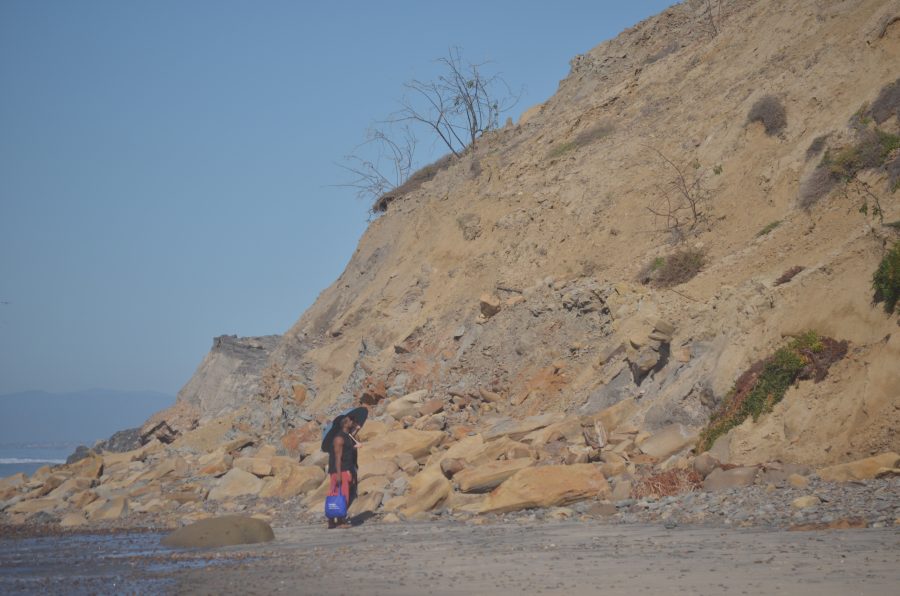The colony of harbor seals at La Jolla’s Casa Beach will be displaced after the 4th District Court of Appeals decided to uphold a 1931 trust and dredge the sand. (Erik Jepsen/Guardian File)
To the dismay of many involved UCSD students and staff, a state appellate court ordered sand dredging at La Jolla’s Casa Beach — better known as the Children’s Pool — last month, thereby ousting a seal colony that has lived at the site for over a decade.
Members of the UCSD community have been active participants in efforts to preserve the seals’ home for several years, despite the site’s historic designation as a children’s area. Students have volunteered to guard the seals’ designated area, educated visitors and conducted research, while others have written letters and spoken at city council meetings.
Dredging the sand requires city officials to declare the seals a public nuisance and health threat. The officials also must acquire permits from the U.S. Army Corps of Engineers and the California Coastal Commission, which has a history of supporting marine wildlife.
Jim Hudnall, charter member of the Society for Marine Mammalogy and the activist who convened the first general public meeting at the La Jolla Public Library in 1999, said he felt let down by the ruling.
“I am dismayed at the appeals court’s decision because the La Jolla harbor seal rookery is the southernmost [one] in the United States,” Hudnall said.
Under a trust established in 1931, in which the governor handed over certain submerged state lands to the city, the beach was intended to be a bathing pool exclusively for children as well as a public park. More than a decade ago, however, seals began gathering and finally overtook the children’s pool, prompting the city to limit access to swimmers, divers and tourists.
The 4th District Court of Appeals ruled 3-0 to restore water quality by dredging the sand and removing the seals, whose feces are said to contaminate the water. Court documents estimate the cost of sand dredging to fall between $250,000 and $500,000.
Hudnall said the land could be returned to the state for management purposes, rendering the court decision moot.
The plan to dredge the beach alarmed UCSD professor emeritus Douglas L. Inman, a specialist in coastal oceanography and sedimentation, because of the impact it would have on the beach and those surrounding it — including accelerated cliff erosion.
“Two years ago I called a meeting and went to the sight to show what would happen,” Inman said. “[The meeting] was attended by city councilmembers and engineers. It would’ve diluted the entire area of sand that right now has a tentative balance.”
Some have suggested the city open the sluiceways, which can serve as gates in the breakwater — originally meant to be open — to allow the ocean water to flow more freely.
“They’ll have to pump sand out to open them, but if the sluice gates function as they were supposed to, it would re-establish some equilibrium,” Inman said.
Rachael VanderWalde is the current education and policy director for the Animal Protection and Rescue League, whose graduate work at Scripps Institution of Oceanography was based in informative signage directly linked to the seals.
“Just looking at the trust without looking at the biological needs, in my opinion, is not the best decision,” she said.
VanderWalde also said that public attitude toward environmental causes has drastically changed since the trust was drafted in 1930, a decade during which the seals were hunted to near extinction.
“Over and over again, we hear the controversy framed as ‘humans versus seals’ when obviously it is not — no seal has ever written a letter or given an interview,” professor of anthropology Jim Moore said in an e-mail. “It is between humans with one definition of recreation: active, sporty, using the environment; and humans with another definition: passive, watching and enjoying the environment.”
The San Diego City Council has proposed a compromise by allowing swimmers to occupy the pool during the summer, while providing special protection during the seals’ birthing and pupping season from December to May by installing a rope barrier.
Revelle College junior Aaron Hieber has volunteered to guard the designated seal area since his freshman year.
“The only in-water human use of the beach I’ve seen there is an entry point for scuba divers,” Hieber said. “I feel the best thing to do would be to remove the sea wall and restore the beach to how it was in 1930, and let nature determine what happens to the seals when the beach is in its natural state.”
Moore said the implications of the court’s decision pertain to more than just the seals.
“[The seals’] presence is a potentially powerful message to all the foreign tourists who visit La Jolla that American concern for wildlife and the environment is not just lip service,” Moore said. “Asking Africans to deal with elephants and lions in the name of conservation, but unwilling to accept any ‘hardships’ ourselves is hypocritical.”
A public opinion poll commissioned by APRL in May showed that eight out of 10 San Diegans favor limits on use of the Children’s Pool to protect the harbor seals.
San Diego City Attorney Michael Aguirre said he intends to appeal the decision to the California Supreme Court.







